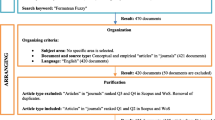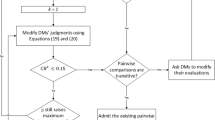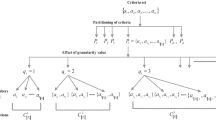Abstract
Linguistic variables are flexible and intuitive attraction for expressing the wording of decision makers. This paper introduces a new type of linguistic fuzzy sets called linguistic dual hesitant fuzzy sets to express the hesitancy of decision makers’ qualitative preferences and non-preferences. Considering the application in decision making, linguistic dual hesitant fuzzy preference relations (LDHFPRs) are introduced that permit the decision makers to apply several linguistic variables to indicate a qualitative preferred judgment and a qualitative non-preferred judgment, respectively. To rank objects from LDHFPRs rationally, a consistency concept is first presented. Then, two optimal models are built to judge the consistency of LDHFPRs. When LDHFPRs are inconsistent, an optimal model-based iteration algorithm for obtaining consistent LDHFPRs is offered. Based on consistent linguistic intuitionistic fuzzy preference relations, a method for calculating the weighted linguistic intuitionistic fuzzy priority vector is introduced. In the setting of group decision making (GDM), a consensus measure based on individually weighted consistent reverse complementary linguistic intuitionistic fuzzy preference relations is defined. When the consensus does not satisfy the requirement, a two-step optimal model-based method for increasing the consensus level is offered. Furthermore, an approach for GDM with LDHFPRs is developed. Finally, an illustrative example concerning the evaluation of basic services internet enterprise websites is provided to show the efficiency of the new method.

Similar content being viewed by others
References
Ahmadimanesh F, Pourmehdi M, Paydar MM (2021) Evaluation and prioritisation of potential locations for investment in dental tourism. Soft Comput 25:15313–15333
Akram M, Luqman A, Kahraman C (2021a) Hesitant pythagorean fuzzy ELECTRE-II method for multi-criteria decision-making problems. Appl Soft Comput 108:107479
Akram M, Adeel A, Al-Kenani AN, Alcantud JCR (2021b) Hesitant fuzzy N-soft ELECTRE-II model: a new framework for decision-making. Neural Comput Applic 33:7505–7520
Atanassov KT (1986) Intuitionistic fuzzy sets. Fuzzy Sets Syst 20:87–96
Cai W, Lai KH (2021) Sustainability assessment of mechanical manufacturing systems in the industrial sector. Renew Sust Energ Rev 135:110169
Chen N, Xu ZS, Xia MM (2013) Interval-valued hesitant preference relation relations and their applications to group decision making. Knowl-Based Syst 37:528–540
Chen YF, Peng XD, Guan GH, Jiang HD (2014) Approaches to multiple attribute decision making based on the correlation coefficient with dual hesitant fuzzy information. J Intell Fuzzy Syst 26:2547–2556
Chen ZC, Liu PH, Pei Z (2015) An approach to multiple attribute group decision making based on linguistic intuitionistic fuzzy numbers. Int J Comput Intell Syst 8:747–760
Darko AP, Liang DC (2020) An extended COPRAS method for multiattribute group decision making based on dual hesitant fuzzy Maclaurin symmetric mean. Int J Intell Syst 35:1021–1068
Dong YC, Xu YF, Li HY (2008) On consistency measures of linguistic preference relations. Eur J OperRes 189:430–444
Dong YC, Hong WC, Xu Y (2013) Measuring consistency of linguistic preference relations: a 2-tuple linguistic approach. Soft Comput 17:2117–2130
Dong YC, Li CC, Xu YF, Gu X (2015) Consensus-based group decision making under multi-granular unbalanced 2-tuple linguistic preference relations. Group Decis Negot 24:217–242
Fagundes MVC, Keler, AC, Teles EO, Vieira de Melo SAB, Freires FGM (2021) Multicriteria decision-making system for supplier selection considering risk: a computational fuzzy AHP-based approach. 19:1564–1572
He MJ, Ma XW, Jin YC (2021) Station importance evaluation in dynamic bike-sharing rebalancing optimization using an entropy-based TOPSIS approach. IEEE Access 9:38119–38131
Herrera F (1995) A sequential selection process in group decision making with linguistic assessment. Inf Sci 85:223–239
Herrera F, Herrera-Viedma E, Verdegay JL (1996) A model of consensus in group decision making under linguistic assessments. Fuzzy Sets Syst 78:73–87
Li WM, Deng X (2020) Multi-parameter portfolio selection model with some novel score-deviation under dual hesitant fuzzy environment. Int J Fuzzy Syst 22:1123–1141
Luqman A, Akram M, Alcantud JCR (2021) Digraph and matrix approach for risk evaluations under Pythagorean fuzzy information. Expert Syst Appl 170:114518
Meng FY, Tang J, Fujita H (2019) Linguistic intuitionistic fuzzy preference relations and their application to multi-criteria decision making. Inf Fusion 46:77–90
Meng FY, Xu YW, Wang N (2020) Correlation coefficients of dual hesitant fuzzy sets and their application in engineering management. J Amb Intel Hum Comp 11:2943–2961
Mo JM, Huang HL (2020) Archimedean geometric Heronian mean aggregation operators based on dual hesitant fuzzy set and their application to multiple attribute decision making. Soft Comput 24:14721–14733
Montserrat-Adell J, Agell N, Sánchez M, Prats F, Ruiz FJ (2017) Modelling group assessments by means of hesitant fuzzy linguistic term sets. J Appl Logic 23:40–50
Oubahman L, Duleba S (2021) Review of PROMETHEE method in transportation. Prod Eng Arc 27:69–74
Parreiras RO, Ekel PY, Martini JSC, Palhares RM (2010) A flexible consensus scheme for multicriteria group decision making under linguistic assessments. Inf Sci 180:1075–1089
Ren ZL, Wei CP (2017) A multi-attribute decision-making method with prioritization relationship and dual hesitant fuzzy decision information. Int J Mach Learn Cy 8:755–763
Ren ZL, Xu ZS, Wang H (2017) Dual hesitant fuzzy VIKOR method for multi-criteria group decision making based on fuzzy measure and new comparison method. Inf Sci 27:388–389
Rodríguez ARS, de Oliveira PV (2022) An extension of systematic layout planning by using fuzzy AHP and fuzzy VIKOR methods: a case study. Eur J Ind Eng 16:1–30
Rodríguez RM, Martínez L, Herrera F (2012) Hesitant fuzzy linguistic term sets for decision making. IEEE Trans Fuzzy Syst 20:109–119
Singh P (2014) A new method for solving dual hesitant fuzzy assignment problems with restrictions based on similarity measure. Appl Soft Comput 24:559–571
Su Z, Xu ZS, Liu HF, Liu SS (2015) Distance and similarity measures for dual hesitant fuzzy sets and their applications in pattern recognition. J Intell Fuzzy Syst 29:731–745
Tanino T (1984) Fuzzy preference orderings in group decision making. Fuzzy Sets Syst 12:117–131
Torra V (2010) Hesitant fuzzy sets. J Intell Fuzzy Syst 25:529–539
Tyagi SK (2015) Correlation coefficient of dual hesitant fuzzy sets and its applications. Appl MathModell 29:7082–7092
Wang HJ, Zhao XF, Wei GW (2014) Dual hesitant fuzzy aggregation operators in multiple attribute decision making. J Intell Fuzzy Syst 26:2281–2290
Wang L, Shen QG, Zhu L (2016a) Dual hesitant fuzzy power aggregation operators based on Archimedean t-conorm and t-norm and their application to multiple attribute group decision making. Appl Soft Comput 38:23–50
Wang SW, Ding XQ, Ding ZZ (2016b) Model for performance evaluation in customs service management with dual hesitant fuzzy information. J Intell Fuzzy Syst 30:2131–2137
Wang ZW, Wu J, Liu XD, Garg H (2021) New framework for FCMs using dual hesitant fuzzy sets with an analysis of risk factors in emergency event. Int J Comput Int Syst 14:67–78
Wang ZR, Zhou L, Mi YL, Shi Y (2022) Measuring dynamic pandemic-related policy effects: a time-varying parameter multi-level dynamic factor model approach. J Econ Dyn Con 39:104403
Wei YX, Wang QH (2021) New distances for dual hesitant fuzzy sets and their application in clustering algorithm J. Intell Fuzzy Syst 41:6221–6232
Wu ZB, Xu GJ (2016) Managing consistency and consensus in group decision making with hesitant fuzzy linguistic preference relations. Omega 65:28–40
Xia MM, Xu ZS (2011) Hesitant fuzzy information aggregation in decision making. Int J Appr Reason 52:395–407
Xu ZS (2004a) Uncertain linguistic aggregation operators based approach to multiple attribute group decision making under uncertain linguistic environment. Inf Sci 168:171–184
Xu ZS (2004b) EOWA and EOWG operators for aggregating linguistic labels based on linguistic preference relations. Int J Uncertain Fuzz Knowl Based Syst 12:791–810
Xu ZS (2005) Deviation measures of linguistic preference relations in group decision making. Omega 33:249–254
Xu ZS (2007) Intuitionistic preference relations and their application in group decision making. Inf Sci 177:2363–2379
Xu YP (2016) Model for evaluating the mechanical product design quality with dual hesitant fuzzy information. J Intell Fuzzy Syst 30:1–6
Xu ZS, Xia MM (2011) Distance and similarity measures for hesitant fuzzy sets. Inf Sci 181:2128–2138
Ye J (2014) Correlation coefficient of dual hesitant fuzzy sets and its application to multiple attribute decision making. Appl Math Modell 38:659–666
Yu DJ, Li DF (2014) Dual hesitant fuzzy multi-criteria decision making and its application to teaching quality assessment. J Intell Fuzzy Syst 27:1679–1688
Yu DJ, Li DF, Merigo JM (2016) Dual hesitant fuzzy group decision making method and its application to supplier selection. Int J Mach Learn Cy 7:819–831
Yuan RP, Meng FY (2020) New similarity measures for dual hesitant fuzzy sets and their application. Int J Fuzzy Syst 22:1851–1867
Yurtyapan MS, Aydemir E (2022) ERP software selection using intuitionistic fuzzy and interval grey number-based MACBETH method. Grey Syst Threoy Appl 12:78–100
Zadeh LA (1975) The concept of a linguistic variable and its application to approximate reasoning–part I. Inf Sci 8:199–249
Zhang HM (2020a) Distance and entropy measures for dual hesitant fuzzy sets. Comput Appl Math 39:1–16
Zhang ZM (2020b) Maclaurin symmetric means of dual hesitant fuzzy information and their use in multi-criteria decision making. Granular Comput 5:251–275
Zhao N, Xu ZS, Liu FJ (2016) Group decision making with dual hesitant fuzzy preference relations. Cogn Comput 31:1119–1143
Zhao H, Xu ZS, Liu SS (2017) Dual hesitant fuzzy information aggregation with Einstein T-conorm and T norm. J Syst Sci Syst En 26:240–264
Zhu B, Xu ZS (2014) Consistency measures for hesitant fuzzy linguistic preference relations. IEEE Trans Fuzzy Syst 22:35–45
Zhu B, Xu ZS, Xia MM (2012) Dual hesitant fuzzy sets. J Appl Math 89:2607–2645
Acknowledgements
The work was supported by the Natural Science Foundation of Changsha in China (No. kq2202112), and the Startup Foundation for Introducing Talent of NUIST (No. 2022r059), National Social Science Fund Project (No. 19BGL064), and the Startup Foundation for Introducing Talent of NUIST (No. 2020r001).
Author information
Authors and Affiliations
Corresponding author
Additional information
Publisher's Note
Springer Nature remains neutral with regard to jurisdictional claims in published maps and institutional affiliations.
Rights and permissions
Springer Nature or its licensor holds exclusive rights to this article under a publishing agreement with the author(s) or other rightsholder(s); author self-archiving of the accepted manuscript version of this article is solely governed by the terms of such publishing agreement and applicable law.
About this article
Cite this article
Meng, F., Zeng, A., Tang, J. et al. Ranking Objects from Individual Linguistic Dual Hesitant Fuzzy Information in View of Optimal Model-Based Consistency and Consensus Iteration Algorithm. Group Decis Negot 32, 5–44 (2023). https://doi.org/10.1007/s10726-022-09797-8
Accepted:
Published:
Issue Date:
DOI: https://doi.org/10.1007/s10726-022-09797-8




